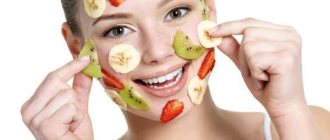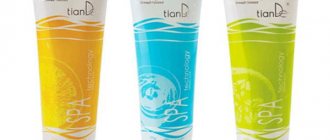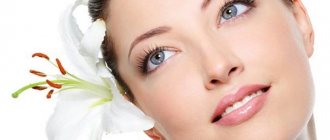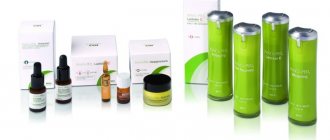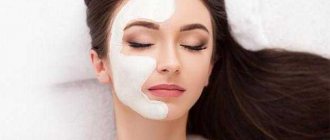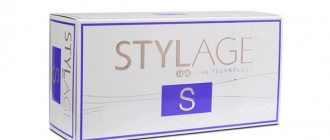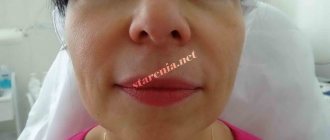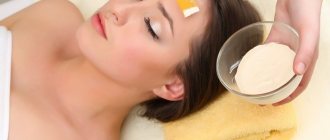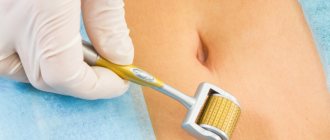Superficial exfoliation is one of the most popular cosmetic procedures. Gentle but effective cleansing, controlled exposure to acids gives an amazing transformation result. The procedure is suitable for all skin types and can solve a whole range of aesthetic problems. The goals are the removal of dead cells, toxins, metabolic products, as well as rejuvenation through the activation of intracellular processes.
Mediderma yellow peeling is used for photo correction and chronoaging. The composition acquires its characteristic color due to the content of vitamin A. The gentle effect allows it to be used for rosacea, to strengthen fragile capillaries. Improves the condition of oily skin, reduces lipid synthesis, eliminates sebaceous plugs and inflammation. The gentle effect allows you to undergo procedures during periods of moderate solar activity. Natural components are hypoallergenic and do not cause irritation.
Description of peelings
Products from the Spanish brand Mediderma have been widely used in the beauty industry for more than 25 years. A group of dermatologists has been developing high-quality and safe products for face and hair care for more than a quarter of a century.
Professional products have received international recognition; the founder of the laboratory, Gabriel Serrano Sanmiguel, has patents in the field of anti-aging cosmetology, chemical peels, and growth factors.
The formulas are created based on raw materials of natural origin. The quality is confirmed by ISO, GMP certificates.
Retises
Contains 3 types of retinol molecules with different speeds of action. Skin immunity is strengthened, pigmentation is whitened, and a healthy, even tone is restored. The procedure is indicated in the presence of age-related changes, as well as to improve the condition of stressed skin, as part of an acne treatment program.
Compound:
- 3 types of retinol - retinol 4%, retinyl 4%, retinal 4%, gently remove keratinized epithelium, stimulate rejuvenation processes, whiten pigmentation, increase tissue tone;
- ascorbic acid strengthens thin blood vessels, increases cellular immunity, improves color, and triggers active metabolic processes;
- hyaluronic acid has an anti-inflammatory effect, soothes irritated skin, copes with peeling, sagging, and maintains hydrobalance;
- zinc normalizes the condition of the oily dermis, stops the spread of infection, and helps control lipid synthesis.
Retises CT
Provides instant transformation results. Quickly restores an even, healthy complexion and smooth structure. Relieves puffiness, signs of fatigue, redness, inflammation. Often used to prepare before a certain event. The superficial effect is not accompanied by a long recovery period; the effect can be assessed immediately after the procedure.
Compound:
- ascorbyl glucoside 10% is a natural vitamin C, stabilized with glucose, helps lighten the tone, eliminates pigmentation, acne marks, refreshes dull skin, prevents aging, protects the skin from ultraviolet radiation;
- Niacinamide 5% helps smooth out superficial wrinkles, activates collagen synthesis, and is used to normalize intracellular metabolic processes;
- retinol 4% and retinyl 1% improve elasticity, cope with sagging, loss of elasticity, remove toxins and oxidants.
Yellow peelings are produced in the form of 5 ml sachets and 2 ml ampoules, the format is convenient for professional peeling, the dosage is enough for 1 session. The cost of an ampoule of yellow peeling retises 3 retinol is about 2500 rubles, the price of a unit of retises ST is 2000 rubles.
Attention! You can purchase it in stores that sell professional care products for salons and aesthetic medicine clinics.
Indications for use
Yellow peeling is one of the safest, most effective exfoliation procedures. Used for all skin types, in the presence of rashes, excessive secretion of glands, as well as for rejuvenation of the integument. The procedure can be carried out according to indications or to maintain the normal state of the dermis. Retinoic peeling affects only the superficial layers of the epidermis, can be included in an anti-aging program, and combines well with other procedures.
Indications:
- aging skin with traces of sagging;
- hyperpigmentation;
- wrinkles of varying degrees;
- oily shine, wide pores;
- comedones, acne;
- rosacea;
- marks after acne.
Composition and action
Retinoic peeling is a type of chemical peeling that contains retinolic acid. It has a rich yellow color. This feature of the acid gave the procedure a second name – yellow peeling.
Retinolic acid is a synthetic analogue of retinol. In addition to this acid, the peeling includes ascorbic, azelaic, koic, and phytic acids. Any of them gives a positive effect for facial skin, as can be seen in the photo.
In terms of healing, yellow peeling is classified as superficial, and in terms of its effect on the skin, it is classified as medium. The first factor allows you to carry out a peeling course in the summer, at a time when other rejuvenation procedures are contraindicated.
But it should be noted that after the procedure you will have to forget about relaxing on the beach for a certain time. Retinolic acid, together with the other peeling components, has a stimulating effect, causing skin cells to divide more actively, which leads to the production of elastin and collagen and an effect on the deeper layers of the skin, helping to retain moisture.
In addition to rejuvenating the skin, retinoic peeling has a disinfecting effect and destroys the harmful effects of bacteria on the skin. This property helps to combat high oily skin. Retinol peeling receives expert reviews as the best prevention against skin diseases.
Peeling effectiveness
Before signing up for the procedure, it is worth finding out what results can be achieved thanks to the course:
- Noticeable rejuvenation occurs, collagen synthesis is activated, elasticity is restored, and the skin becomes denser.
- The degree of cellular immunity increases, the epidermis becomes less sensitive to various infections, bacteria, and adverse environmental factors.
- An even, healthy tone is restored, thanks to the effects of retinols, the production of melanin is blocked. Whitens pigmentation and acne marks.
- A pronounced lifting effect is observed, the number of fine wrinkles is reduced. Photo and bioaging processes are prevented.
- The work of the sebaceous glands is normalized, pores are narrowed, toxins and metabolic products are released.
What are the main benefits of a retinol peel?
There are both short-term and long-term benefits that can be obtained from a retinol peel procedure.
After a retinol peel, your skin will feel hydrated and more balanced due to the increased number of renewed skin cells that are now on the surface.
This treatment is also great for anti-aging and can minimize the appearance of wrinkles by increasing skin elasticity as well as slowing down the breakdown of natural collagen.
Is it possible to do the procedure yourself?
Retinoic exfoliation can only be performed by a specialist. A cosmetologist can professionally assess the condition of the skin, carry out the procedure according to the protocol, and give recommendations during the recovery period. It is difficult to independently control the depth of exposure to active elements; it can lead not only to the development of hypersensitivity, inflammation, irritation, but also to burns. At home, you can use care products containing no more than 1% retinol.
How much does the procedure cost in salons?
The yellow peeling procedure can be performed in many aesthetic medicine salons and clinics. The price varies from 3500 rub. up to 6,000 rubles, determined depending on the individual characteristics of the patient.
Additional restorative masks, creams, and hardware procedures may be required to enhance the effect of the procedure.
The main feature of professional peeling is determining the individual needs of the patient’s skin. Only an experienced specialist can assess the condition of the skin and prescribe the optimal program. It is difficult to correct aesthetic problems at home. It is not recommended to use the TimeCode series on your own; there is a high risk of complications, hypersensitivity, burns, and scars.
Preparatory stage
Yellow peeling is carried out in the salon by an experienced cosmetologist. To achieve the desired goals, you should follow all the doctor’s recommendations. A responsible campaign will ensure a lasting, pronounced result. The doctor will assess the condition of the integument, take an anamnesis, and may require consultation with specialists. The preparation stage begins a month in advance and includes a number of rules:
- It is advisable to add fruit acids to cosmetic products, this will enhance the effect of peeling; the concentration of retinol should not exceed 1%;
- for dry skin, as well as for patients over 35–40 years of age, it is recommended to carry out mesotherapy and biorevitalization first;
- if you are prone to herpes inflammation, the doctor will prescribe preventive antiviral drugs;
- You cannot sunbathe, visit the solarium, and you must refuse the pool, sauna, or gym a week before the scheduled session;
- The composition must be tested for a possible allergic reaction.
Note! Professional peelings are not recommended during periods of maximum solar activity. Cosmetologists advise taking the course from October to March, this will prepare the skin for the spring-summer season, avoiding the appearance of pigmentation.
Preparing for yellow peeling
It is better to start preparing 2 weeks before the first procedure. Initially, you need to visit a cosmetologist. He will examine the skin, collect information about your health status, existing problems and past diseases. It is imperative to notify a specialist about the use of drugs with retinol and the presence of allergic reactions. The doctor may recommend a preliminary course of procedures with a gradual increase in the concentration of the main drug. They are used for superficial peeling of the skin. The essence of this method is to soften the superficial stratum corneum so that peeling agents can easily penetrate into the dermis. Additionally, it is possible to eliminate inflammatory processes.
How does the procedure work?
Retinoic peeling can only be entrusted to a specialist. After examining and assessing the condition of the skin, a cosmetologist will be able to select the optimal composition and means for preparing the skin.
Protocol:
- Cleansing mousse is applied to the entire surface of the face. After 15 minutes, it is washed off and excess moisture is removed with cosmetic wipes.
- The peeling composition is applied in strict sequence. First of all, the forehead, chin, cheeks are treated, then the wings of the nose, perioral, periorbital area, and eyelids.
- The cosmetologist can choose one of the methods - using a brush for surface treatment or spreading with rubbing movements with cotton pads for deeper penetration. First, the contents of the ampoule are applied, then the sachet.
- Cover your face with film for 25 minutes. Also, the cosmetologist can change the time, how long to keep on the face depends on the individual characteristics of the skin. The patient may feel a burning, tingling sensation.
- The film is then removed and the patient can go home.
- After 6–8 hours, the peeling is washed off with plenty of warm water and neutral soap, excess moisture is removed with cosmetic wipes.
- At the final stage, a moisturizing or nourishing cream is applied depending on the type and needs of the skin.
Healing period
After the procedure, discomfort will be present for several days; the final result can be assessed only after a week. Increased sensitivity, tightness, swelling, redness are standard symptoms after yellow peeling. Closer to the third day, the temperature may rise. In most cases, separation of the epithelium is observed, the process is accompanied by severe peeling. During this period, you should follow the cosmetologist’s recommendations for a quick recovery:
- limit touching your face, do not use makeup for several days;
- in the first week you cannot visit the solarium, gym, sauna, or swimming pool;
- post-peeling products Retises, Factor G, Vit-C Medoderm are used for care; hormonal drugs are not used;
- Before going outside, use sunscreen; a cosmetologist will help you choose based on your skin phototype and season;
- you need to drink as much water as possible to speed up tissue recovery;
- You cannot peel off the crusts yourself; only 2 weeks after the procedure you can carry out a light scrub or gommage recommended by a specialist.
Some cases of using medium anti-aging peels
Medium chemical peels are often the treatment of choice when it comes to anti-aging treatments. However, the presence of a number of concomitant aesthetic defects in the patient forces some doctors to abandon this technique for fear of complications. Are they doing the right thing? Is it possible to use medium peels in such situations without fear of harming the patient?
The main customer complaints associated with age-related skin aging include deepening of facial wrinkles, the appearance of pronounced static wrinkles, and deformation of soft tissues. Medium chemical peeling is one of the techniques that allows you to restore the characteristics of young skin, stimulating the renewal of its cells through the formation of collagen and elastin fibers.
Whitening preparations with licorice and mulberry extracts are used in the pre-piping period for hyperpigmented skin.
Classic schemes for performing mid-grade anti-aging peels Of course, a comprehensive solution to the problem using several correction methods allows one to achieve better anti-aging results. However, you need to start therapy with peelings, using them as a basic method of stimulating the dermis. And only after 2-3 procedures should aesthetic care, laser therapy, myostimulation, radiolifting, etc. be included. Any medium peel requires adequate preparation. To do this, the patient is first prescribed acidic drugs with optimized pH (5-5.5; 6-6.5) for at least 2 weeks. For dry skin - with lactic or glycolic acid. For oily skin - with salicylic acid. For skin with keratosis - with salicylic or mandelic acid. Then, with an interval of 10-14 days, 1-3 superficial peeling procedures are performed with low pH preparations.
Yellow peelings Yellow (retinoic) medium peelings are used only in courses with equal intervals between procedures, since this implementation makes it possible to achieve a pronounced rejuvenating effect. On average, they are done once every 2 weeks, with slow skin regeneration - once every 3 weeks. There is also an extreme way of performing yellow peeling (it is called “liquid laser”) - 6 procedures in 6 days. On the 10-14th day after the yellow peeling, biorevitalization is indicated: by this moment, elastin and collagen begin to be actively produced in the skin, so the introduction of hyaluronic acid accelerates the post-peel recovery process, allows the skin to look full, moisturized, and smoothes out fine wrinkles.
Jessner peeling Jessner peeling can be performed once if the result suits both the patient and the doctor. If one procedure is not enough, after some time (but not less than three weeks) you can perform a second one. To maintain the achieved effect, it is necessary to carry out superficial peeling every 2 months depending on your skin type.
TCA Peeling Peeling with trichloroacetic acid can also be applied once. The result is maintained with light superficial peels once every 2-3 months. To avoid complications, TCA peeling is repeated no more than 8 times a year.
Coffee and phenol peelings Both of these peels also do not require a course of use. If after one procedure the achieved effect seems insufficient, it can be repeated after a few weeks, but you should not perform more than 5 procedures per year. Based on the principle of action, these two peels are very similar, but formulations with caffeic acid are less toxic. Both cause significant inflammation, promoting a strong lifting of the skin, similar to “shrinkage.” This effect increases over a period of one and a half to two months and lasts up to half a day if it is not supported by anything. To prolong the tightening effect, one superficial peeling procedure every one and a half to two months is sufficient.
The more persistent the pigmentation, the older it is, the more times any cosmetic treatment has been applied to it (peels, whitening agents in home care, photo or laser treatment), the longer the pre-peeling stage should be.
Aesthetic problems that complicate peeling Very often, age-related changes are accompanied by vascular skin problems, the presence of age spots, rosacea, increased sensitivity, etc. That is, aesthetic flaws that require special attention. Being a rather aggressive procedure, a midline chemical peel, if performed according to the classical scheme, can aggravate these problems. But this does not mean that the use of acids in anti-aging procedures should be completely abandoned.
Medium TCA peels can be performed no more than 8 times a year.
Hyperpigmentation Many experts rightly believe that the condition of aging skin with pigment spots can significantly worsen after a mid-peel if the doctor did not adequately prepare for the effects of acid or neglected whitening additives during the procedure, or did not take into account the presence of hyperpigmentation in the post-peel period. Preparing skin with hyperpigmentation of any etiology for medium peels includes several stages.
1. Daily use of whitening preparations for one and a half months. Moreover, the more persistent the pigmentation, the older it is, the more times any cosmetic effect has been applied to it (peelings, whitening preparations in home care, photo or laser treatment), the longer the pre-peeling stage should be.
For rosacea and demodicosis, phenol or trichloroacetic peels should not be prescribed. Resorcinol formulations can be used, but with a small amount of resorcinol. If there is a need for Jessner peeling, then preparation for it should be longer.
2. Carrying out two or three procedures of superficial AHA peels. For daily use, medications with a whitening effect are prescribed, which include kojic acid, arbutin, 4N-butylresorcinol (resorcinol derivative), plant extracts (mulberry, licorice, etc.). Their whitening effect is based on suppressing the activity of tyrosinase, and, accordingly, melanogenesis. In addition, during the preparatory period, the patient must use sunscreen every morning. 2 weeks before the first procedure, drugs with glycolic are added. lactic or mandelic acid. Then 2-3 procedures of any superficial peeling are performed according to the skin type in order to prepare it for the effects of more concentrated acidic compounds. Underestimation of this important stage can provoke increased hyperpigmentation literally the next day after the mid-peel. Medium peels for hyperpigmentation are carried out with whitening additives: they are either included in the peels or are available in the form of separate preparations (ampoules concentrates, gels), which are applied to the entire surface of the skin or to pigmented areas. The method of their use depends on the manufacturer's recommendations. Many experts note that although medium peeling has a weaker effect on skin with age spots, rehabilitation after it takes longer. Therefore, regenerating agents are prescribed for home care, and whitening drugs are completely canceled for one week. Then, as a rule, they return to those that were at the preparatory stage.
Soothing products with calendula and string are prescribed for pre-peeling preparation of skin with rosacea symptoms.
If the pigmentation is very persistent, then strong antioxidant preparations, for example with resveratrol, alpha-lipoic acid, etc., are added to home care. Sunscreens should have a maximum protection factor (50) and be used within a month after the procedure. Then the degree of protection can be gradually reduced to 30-35.
Vascular problems Cuperosis, erythrosis, multiple telangiectasias located on the entire face or most of it require home care medications for both external and internal use. Polyunsaturated fatty acids, angioprotectors, antioxidants with polyphenols (horse chestnut, vitamin A, pharmaceutical preparations auriderm, escin, ascorutin) are prescribed. You need to start using them a month and a half before the mid-peeling (nanopreparations act faster). Skin with single telangiectasias, usually located near the nose, does not require special pre-peeling preparation - small spider veins are covered with a protective cream during the procedure. Two superficial peels before the median peels are performed as usual, since the vessels have already been prepared for the effects of drugs with a low percentage of acid by home care. During the mid-peeling procedure, vascular strengthening drugs (ampoules or aerosols) are required. The method of applying them depends on the manufacturer's recommendations. On the 4-6th day after the procedure, arnica or rutoside and microcurrent therapy are prescribed to restore microcirculation (several procedures will be required if the swelling lasts a long time). To optimize repair - iruksol, olazol, products with chitosan, aloe, organic silicon.
Increased skin sensitivity Preparing such skin for peeling takes at least 3-6 weeks, and sometimes more. For this period, drugs with low ANA content (2-5%) are prescribed. Then a course of superficial peelings is carried out (if it is necessary to strengthen the protective properties of the skin, mesotherapy with depanthenol or pantolactone is carried out 2-3 weeks before peelings).
All medium peels except those are suitable for sensitive skin. that contain resorcinol (for example, Jessner peel). Between medium peeling procedures (if they are carried out in a course), the intervals increase to at least 4-6 weeks. The recovery period is supplemented with preparations with ceramides, shea butter, polyphenols, that is, moisturizers that have a slight occlusion effect. For minor regeneration, sensitive skin needs components with an immunomodulatory and anti-inflammatory effect (for example, Vit and Polnoksidonium). They are meant for 5-7 days. Increased skin sensitivity is often associated with a patient’s history of aggravated allergies or with the so-called readiness of the body for an allergic reaction. In this case, it is important to carefully monitor the skin's reaction during peeling. If something went wrong (for example, red spots, plaques, vesicles, etc.) appeared. it is necessary to interrupt the procedure and carry out anti-anaphylactic measures. In order to prevent such phenomena for skin with increased sensitivity to allergies, antihistamines are prescribed 2 days before the mid-chemical peel. After the procedure, steroidal anti-inflammatory drugs are added to them for 5-7 days. We must remember that an allergic reaction may not develop immediately after peeling, but on the 3-4th day.
Rosacea, demodicosis The presence of rosacea and especially demodicosis on the skin always indicates increased sensitivity and the presence of vascular pathology. These phenomena may be accompanied by papulopustular rashes. Preparatory activities for peeling take approximately a month. For 2-3 weeks, anti-demodicosis therapy is carried out with metragyl, permethrin or baziron, external anti-inflammatory, vaso-strengthening drugs, sedatives with herbal ingredients (extract of calendula, chamomile, string, aloe) are prescribed. Sometimes it is suggested to use fungicidal-acaricidal ointment “Yam”, which contains sulfur and increases skin sensitivity. In this case, superficial peelings can be carried out no earlier than 10 days after stopping its use.
Yellow peels are good for acne-prone skin, but after the 2-3rd procedure they can cause an increase in breakouts. The patient should be warned about this. After completing a course of peelings, in addition to the rejuvenating effect, it is usually possible to achieve long-term remission of acne tard.
In superficial peels, compositions with azelaic acid and azeloglycine are used (they have a vaso-strengthening, anti-inflammatory and immunomodulatory effect), with ferulic acid, which is a polyphenol and has antioxidant properties, with vitamin C. Peels with salicylic acid or a combination of salicylic and azelaic acid are used as medium peels. acids For dense, porous, reddish skin with papulopustular rashes, preference is given to a procedure that includes several peeling compounds: for example, peeling with salicylic and azelaic acids (affects rosacea and papulopustular rashes), pyruvic acid (anti-aging, anti-inflammatory and moisturizing). action) and retinol (enhances the anti-aging effect). For rosacea and demodicosis, phenol and trichloroacetic peels should not be prescribed. Resorcinol formulations can be used, but with a small amount of resorcinol. If there is a need for Jessner peeling, then preparation for it should be longer. The recovery period requires, in addition to the usual means used in post-peeling care, the use of non-steroidal anti-inflammatory drugs (indomethacin, Traumeel). If rashes are noticed on the 2nd-3rd day, then Trichopolum is needed, and from the 4th-5th day - Rosamet cream. If on the 3rd-4th day there is a deterioration in the condition of the skin, then immunomodulators are added.
Acne tarda Acne tarda (late acne) are of a hormonal nature and are most often localized in the lower third of the face, sometimes the temporal zone is affected. Patients with this diagnosis are prescribed anti-inflammatory therapy for a month, including mild cleansers and moisturizers for sensitive skin. Then for 2 weeks, as usual, acid preparations. If the skin is sensitive and/or has symptoms of rosacea, then a course of superficial peelings is necessary. Yellow peels are good for this type of skin, but after the 2-3rd procedure they can cause an increase in rashes. The patient should be warned about this. After completing the course, in addition to the rejuvenating effect, it is usually possible to achieve long-term remission of acne tard. Specialists should not forget about combined peeling with salicylic, pyruvic and trans-retinoic acids. It provides a rejuvenating effect and is recommended specifically for acne. A combination of coffee and pyruvic peeling is also used. A common complication after a median peel in the presence of acne tard is the addition of a staphylococcal infection. In this case, antibacterial drugs and Curiosin gel are prescribed for 5-6 days immediately after peeling. The presence of certain aesthetic defects in a patient with aging skin, as a rule, is not a contraindication to medium peeling, but requires a thoughtful approach from a specialist based on knowledge of the mechanisms of skin reaction to medium peels, the possibilities of these peels, tactics for managing the patient during the rehabilitation period and other nuances.
| POSSIBLE CONTRAINDICATIONS CONSULTATION WITH A SPECIALIST IS REQUIRED Specialists do not provide consultations over the phone, you must make an appointment for a consultation. | Place an order Ask a question |
Precautionary measures
Despite the versatility of use for different age groups and skin types, mederma peeling has a number of limitations for its implementation. During the consultation, the cosmetologist not only assesses the condition of the skin, but also collects an anamnesis.
You can trust the procedure only to an experienced specialist with a medical education. Only in this case can the likelihood of complications develop be minimized.
Contraindications:
- individual intolerance;
- pregnancy, lactation;
- spring-summer period;
- atopic contact dermatitis, ichthyosis;
- taking roaccutane;
- herpes;
- skin photosensitivity;
- active inflammatory processes;
- damage to the integrity of the integument;
- previous hepatitis, liver pathologies;
- warts, papillomas in the affected area.
In addition to the standard consequences in the form of redness and swelling, the temperature may rise , peeling is observed within 5–7 days, and the epithelium will peel off.
Important! Painful, increasing symptoms, the appearance of local redness, ulcers, and burns should alert you. In such cases, you need to contact a cosmetologist.
Advantages and disadvantages
Retises peelings are distinguished by their effective action and fast healing period. The procedure has no age restrictions and is used to care for all skin types. Before you decide to exfoliate, you should learn about the main advantages and disadvantages.
Pros:
- the result is noticeable after the first session;
- allows you to solve a whole range of aesthetic problems;
- suitable for all skin types, including sensitive;
- has a short recovery period;
- side effects are excluded.
Minuses:
- requires coursework;
- high price;
- carried out by a cosmetologist in a salon or aesthetic medicine clinic;
- superficial exposure is not effective for pronounced age-related changes.
Result
The effect becomes noticeable a week after the sessions and lasts for six months. Moreover, this effect will only improve over time. The acid burns the keratinized top layer of skin and promotes the creation of a new layer, without wrinkles and other problems. The skin tone will become even, and blackheads and pimples will disappear.
The number of sessions depends on the age and characteristics of the skin. For some people, one time is enough, while others need to do three courses after twenty days and 40 days to get results. For them, the course of sessions lasts one and a half months.
To maintain the achieved effect, sessions should be carried out once a year or six months. After sessions, a recovery period is required, so it is better not to do sessions 12 days before special meetings or important events.
Comparison with analogues
Mediderma produces highly effective peelings based on vitamin A. The composition delicately cleanses and launches rejuvenation processes. An entire program has been developed, consisting not only of peeling products, but also of products to prolong the result.
The company Kosmoteros produces peelings based on retinoic acid. The composition also includes vitamin C and E. It has the most gentle effect and is used to impart freshness and eliminate signs of fatigue.
Martinex created a peeling with retinol, kojic acid. Effectively whitens pigmentation, copes with acne marks, and is used for patients with sensitive skin.
Peels from the domestic brand Arcadia, in addition to the ampoule concentrate, include day and night cream. The formula provides gentle exfoliation and has a short recovery period.
Opinion of cosmetologists
Beauty industry professionals actively share their experience of yellow peeling.
The cosmetologist asks his colleagues about the dosage of Cosmoteros, writes that it is more convenient to take packaged Mediderma.
The specialist is interested in company representatives to replenish stocks.
A cosmetologist writes about the positive experience of using almond and azelaine peeling. Many clients experience active breakouts when using ferulic.
Professional or DIY - which is better?
You can buy Cimel retinoic peeling and do it yourself. You just need to carefully study the procedure protocol and strictly follow the rules for working with the substance. The drug is presented in a convenient format that does not create difficulties when using the product. This does not mean that doing it yourself is a good solution. Retinoic peeling requires taking into account many nuances that are important to obtain an effective result without complications. Only a professional cosmetologist can easily cope with the task.
Patient reviews
On the Internet you can find many reviews from patients who have experienced the effects of Mediderma peels.
The user describes his experience with retinoic peeling and indicates that in order to achieve the rejuvenation effect, a course of procedures is required.
The participant writes that after use the skin peeled a little, the result depends on the individual characteristics of the skin.
The review states that with such consequences the effect is insufficient.
But there are also disappointed clients. The user writes about the high cost incommensurate with the weak result.
Prices for services
| Name of service | Price |
| Primary appointment (examination, consultation) with a dermatovenerologist | 1800 rub. |
| Repeated appointment (examination, consultation) with a leading specialist dermatovenerologist | 2000 rub. |
| Primary appointment (examination, consultation) with a leading specialist dermatovenerologist | 2300 rub. |
| Dermatological retinoic peeling | 5200 rub. |
